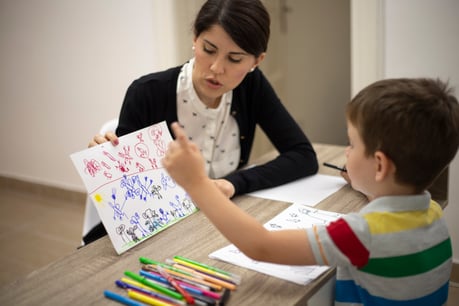A Guide to Data Collection for Applied Behavior Therapy (ABA) for Autistic Children
This step-by-step guide is focused on teaching new skills using ABA therapy for an autistic child.
Today we are going to discuss the basics of collecting data when teaching your child new skills. Data collection is a necessary part of any applied behavior analysis (ABA) program. It provides vital information about how the child is doing with that skill, if they are making progress, and can even help to troubleshoot when progress is not being made. It is also the best way to determine if the child is ready to learn a new or more difficult skill.
Before we discuss data collection it may be helpful to go through the basics of what is called discrete trial instruction (DTI). DTI is a method of instruction that breaks things down into brief learning opportunities called “trials.”

Data should be collected for every trial:
- For example, this would be considered one trial:
- Adult says “car”
- Child hands the adult a toy car
- Adult says “good job”
- The elements involved in discrete trial instruction include:
- Adult gets child’s attention (sitting with hands down, looking at adult or materials)
- Adult presents the instruction
- The child responds to the instruction
- Adult delivers consequence (praise and/or reinforcing item)
- Inter-trial interval - the brief time before the next trial is presented
Let’s break these elements down a bit further:
Adult gets the child’s attention
- When teaching at home try to create a distraction-free environment if possible
- No TV or music on
- Only teaching materials should be located on the table
- If your child has difficulty with presenting “ready” behavior before presenting an instruction try presenting an easy instruction they know how to do (such as imitating clapping or touching different body parts).
Adult presents the instruction
- Use as few words as possible in the instruction (especially for younger children)

Child responds
- Make sure you are clear about what response you expect from the child
- If the child does not respond within 5 seconds consider:
- Repeating the instruction
- Providing a prompt:
- Physical – guiding them to complete the response
- Model – adult completes the response and provides an opportunity to imitate
- Vocal – adult provides further spoken instruction to help them complete the response
Adult delivers a consequence
If the child responds correctly and independently provide positive reinforcement such as:- Praise – “Good job” or give a high five
- Sticker
- Preferred toy
- Preferred food item
Data Collection
- Following the child’s response, it is important to record the response so you can track how the child is doing and know when that skill has been learned and they are ready to move on to a more difficult skill.
- One option is to simply place a plus (+) if the child responded correctly or a minus (-) next to the trial if the child responded incorrectly or did not respond at all.
- You may want a bit more information. The other option, then, would be to write exactly what the required response was, what the child selected, and if you provided a prompt if it was successful or not (did the child provide the correct response after the prompt was provided)
- For example, if you were teaching a child to identify pictures of animals and you had 3 pictures on the table in front of them (e.g., horse, pig, cow) your data collection could look like this:
|
Trial |
Left |
Middle |
Right |
Response |
|
Cow |
Pig |
Horse |
+ |
|
Pig |
Horse |
Cow |
Prompted + |
|
Horse |
Cow |
Pig |
- |
|
Pig |
Cow |
Horse |
Prompted - |
|
Horse |
Pig |
Cow |
+ |
|
Cow |
Horse |
Pig |
+ |
- The (+) means the child responded correctly on their own
- The (-) means the child responded incorrectly on their own
- The Prompted + means you provided a prompt and they responded correctly after the prompt
- The Prompted – means you provided a prompt and they responded incorrectly after the prompt
- The circles show what picture the child selected
Although you certainly do not have to use such a detailed data collection method, the more information that is included will help determine how the child is doing with the skill. It will also help with troubleshooting if they are having difficulty with the skill.

You collected data, now what?
- Consider deciding how well you want the child to perform the skill before you consider the skill “learned” by the child. For example, do they need to respond correctly and independently 100% of the time or can they get a few wrongs?
- A general rule of thumb to follow is that for skills that you need the child to complete correctly every single time, the skill should be 100% independent before you move on, such as hand washing. For things like completing addition problems, it is more common to allow a few errors.
- For skills in which errors are ok, it is generally considered best to expect the child to respond correctly and independently at least 80% of the time.
- To determine this percentage, use the number of times or trials you presented the skill to the child, count how many independent correct (+) responses there were, and divide that by the total number of trials.
- For example, from the datasheet example above there were 6 trials and the child responded independently and correctly 3 times. Which would be 3/6 = 50%

Ashley Kemmerer
Ashley Kemmerer has been working in the field of ABA for more than 10 years and has been a board certified behavior analyst (BCBA) for the last 8 years. She is currently pursuing a Ph.D in applied behavior analysis and works as a clinical supervisor for Graham Behavior Services in New Jersey. Ashley has worked primarily with children and adolescents with various diagnoses in the school, home, and residential settings throughout her career in ABA. She has always been passionate about working with individuals with special needs and is thankful to have made a career out of it.




